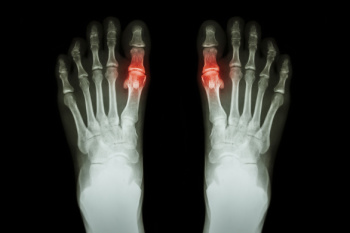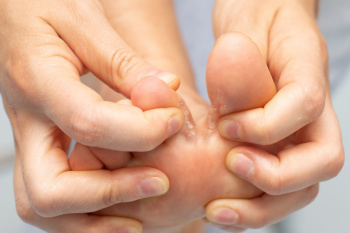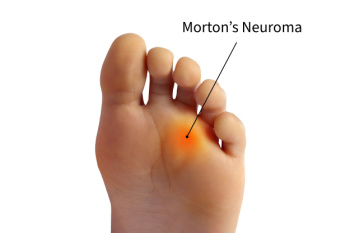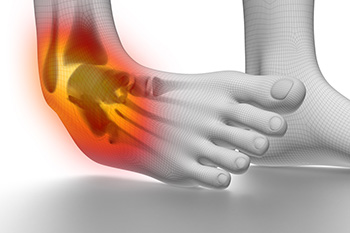Blog
Items filtered by date: June 2025
Get Proper Treatment for Ankle Injuries
Understanding Painful Gout

Gout is a form of inflammatory arthritis caused by the buildup of uric acid crystals in the joints, often affecting the big toe. This buildup, known as hyperuricemia, occurs when the body produces too much uric acid or fails to eliminate it efficiently. Common causes include a diet rich in purines, kidney dysfunction, or certain medications. Symptoms involve sudden and intense big toe joint pain, redness, swelling, and warmth. Diagnosis is made through blood tests, imaging, or joint fluid analysis. A podiatrist can help manage gout flares, recommend footwear modifications, and offer strategies to reduce pressure on affected joints. If you have had one or more gout attacks, it is suggested that you are under the care of a podiatrist who can help you to manage this painful condition.
Gout is a foot condition that requires certain treatment and care. If you are seeking treatment, contact Christian Smith, DPM from UTOEpia Foot and Ankle Specialist. Our doctor will treat your foot and ankle needs.
What Is Gout?
Gout is a type of arthritis caused by a buildup of uric acid in the bloodstream. It often develops in the foot, especially the big toe area, although it can manifest in other parts of the body as well. Gout can make walking and standing very painful and is especially common in diabetics and the obese.
People typically get gout because of a poor diet. Genetic predisposition is also a factor. The children of parents who have had gout frequently have a chance of developing it themselves.
Gout can easily be identified by redness and inflammation of the big toe and the surrounding areas of the foot. Other symptoms include extreme fatigue, joint pain, and running high fevers. Sometimes corticosteroid drugs can be prescribed to treat gout, but the best way to combat this disease is to get more exercise and eat a better diet.
If you have any questions, please feel free to contact our office located in Memphis, TN . We offer the newest diagnostic and treatment technologies for all your foot care needs.
Complications From Athlete’s Foot Blisters

Athlete’s foot can lead to painful blisters that form on the soles of the feet or between the toes. These blisters, often filled with clear or yellowish fluid, may occur even in areas without friction and can become more than just a source of discomfort. When athlete's foot blisters break open, they expose the skin to bacteria, increasing the chance of infection. Signs of a developing bacterial infection may include redness, swelling, pus, or a sensation of warmth in the affected area. In more serious cases, the infection can spread deeper into the foot or affect nearby lymph nodes. These blisters should not be popped, as removing the protective layer increases the risk of complications. Ongoing exposure to moisture and fungi may also lead to repeat infections or allergic reactions, further irritating the skin. A podiatrist can assess blistering caused by athlete’s foot, identify signs of infection, and recommend appropriate treatment. If blisters from an athlete's foot infection are causing problems, it is suggested that you schedule an appointment with a podiatrist for appropriate treatment options.
Athlete’s foot is an inconvenient condition that can be easily reduced with the proper treatment. If you have any concerns about your feet and ankles, contact Christian Smith, DPM from UTOEpia Foot and Ankle Specialist. Our doctor will treat your foot and ankle needs.
Athlete’s Foot: The Sole Story
Athlete's foot, also known as tinea pedis, can be an extremely contagious foot infection. It is commonly contracted in public changing areas and bathrooms, dormitory style living quarters, around locker rooms and public swimming pools, or anywhere your feet often come into contact with other people.
Solutions to Combat Athlete’s Foot
- Hydrate your feet by using lotion
- Exfoliate
- Buff off nails
- Use of anti-fungal products
- Examine your feet and visit your doctor if any suspicious blisters or cuts develop
Athlete’s foot can cause many irritating symptoms such as dry and flaking skin, itching, and redness. Some more severe symptoms can include bleeding and cracked skin, intense itching and burning, and even pain when walking. In the worst cases, Athlete’s foot can cause blistering as well. Speak to your podiatrist for a better understanding of the different causes of Athlete’s foot, as well as help in determining which treatment options are best for you.
If you have any questions please feel free to contact our office located in Memphis, TN . We offer the newest diagnostic and treatment technologies for all your foot and ankle needs.
What Is Morton's Neuroma?

Morton’s neuroma is a painful condition that affects the ball of the foot, usually between the third and fourth toes. It occurs when the tissue surrounding a nerve thickens due to irritation or compression, often caused by wearing tight shoes, high heels, or repetitive stress on the feet. People with Morton’s neuroma often describe a sharp, burning pain in the ball of the foot, along with tingling, numbness, or the sensation of standing on a pebble. Symptoms usually worsen with walking or wearing poorly fitting shoes and may temporarily improve with rest or shoe removal. A podiatrist can diagnose Morton’s neuroma through a physical exam and may use imaging tests like ultrasounds or MRI scans to confirm the diagnosis. Treatment options include shoe modifications, custom orthotics, anti-inflammatory medications, and corticosteroid injections. In some cases, surgery may be required to remove the affected nerve. If you have this painful condition, it is suggested that you schedule an appointment with a podiatrist for appropriate treatment solutions.
Morton’s neuroma is a very uncomfortable condition to live with. If you think you have Morton’s neuroma, contact Christian Smith, DPM of UTOEpia Foot and Ankle Specialist. Our doctor will attend to all of your foot care needs and answer any of your related questions.
Morton’s Neuroma
Morton's neuroma is a painful foot condition that commonly affects the areas between the second and third or third and fourth toe, although other areas of the foot are also susceptible. Morton’s neuroma is caused by an inflamed nerve in the foot that is being squeezed and aggravated by surrounding bones.
What Increases the Chances of Having Morton’s Neuroma?
- Ill-fitting high heels or shoes that add pressure to the toe or foot
- Jogging, running or any sport that involves constant impact to the foot
- Flat feet, bunions, and any other foot deformities
Morton’s neuroma is a very treatable condition. Orthotics and shoe inserts can often be used to alleviate the pain on the forefront of the feet. In more severe cases, corticosteroids can also be prescribed. In order to figure out the best treatment for your neuroma, it’s recommended to seek the care of a podiatrist who can diagnose your condition and provide different treatment options.
If you have any questions, please feel free to contact our office located in Memphis, TN . We offer the newest diagnostic and treatment technologies for all your foot care needs.
Severity Levels of Ankle Sprains and a Podiatrist’s Role

Ankle sprains occur when the ligaments that support the ankle are stretched or torn, often due to a sudden twist, fall, or misstep on uneven surfaces. This injury is common in sports and daily activities that involve quick changes in direction. Ankle sprains are classified into three grades. A mild sprain, or Grade 1, involves slight stretching of the ligament, while a moderate sprain, or Grade 2, includes partial tearing and more noticeable swelling. A severe sprain, or Grade 3, means the ligament is fully torn, leading to significant instability. Symptoms can include pain, swelling, bruising, and difficulty walking. A podiatrist can evaluate the injury, recommend the appropriate treatment, and provide supportive devices to promote proper healing. If you have sprained your ankle, it is suggested that you promptly contact a podiatrist who can accurately diagnose and treat ankle sprains.
Ankle sprains are common but need immediate attention. If you need your feet checked, contact Christian Smith, DPM from UTOEpia Foot and Ankle Specialist. Our doctor can provide the care you need to keep you pain-free and on your feet.
How Does an Ankle Sprain Occur?
Ankle sprains take place when the ligaments in your ankle are torn or stretched beyond their limits. There are multiple ways that the ankle can become injured, including twisting or rolling over onto your ankle, putting undue stress on it, or causing trauma to the ankle itself.
What Are the Symptoms?
- Mild to moderate bruising
- Limited mobility
- Swelling
- Discoloration of the skin (depending on severity)
Preventing a Sprain
- Wearing appropriate shoes for the occasion
- Stretching before exercises and sports
- Knowing your limits
Treatment of a Sprain
Treatment of a sprain depends on the severity. Many times, people are told to rest and remain off their feet completely, while others are given an air cast. If the sprain is very severe, surgery may be required.
If you have suffered an ankle sprain previously, you may want to consider additional support such as a brace and regular exercises to strengthen the ankle.
If you have any questions please feel free to contact our office located in Memphis, TN . We offer the newest diagnostic tools and technology to treat your foot and ankle needs.

